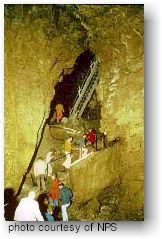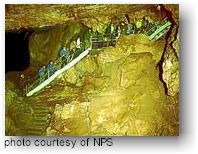


|

|
Monument Overview | Facilities
 |
 |
| Description
Oregon Caves National Monument is small in size, 480 acres, but rich in diversity. Above ground, the monument encompasses a remnant old-growth coniferous forest. It harbors a fantastic array of plants, and a Douglas-fir tree with the widest known girth in Oregon. Three hiking trails access this forest. Below ground is an active marble cave created by natural forces over hundreds of thousands of years in one of the world's most diverse geologic realms. |
Monument Information
Hours/Seasons: Spring:
March 15 - April 30: 10am - 4pm Tours given at 10, 11:30, 1, 2:30, 4 May
1 - May 25: 9am - 5pm Tours given on the Hour. Directions: The monument is located 20 miles east of Cave Junction, Oregon, at the end of State Highway 46. From Interstate 5 at Grants Pass, Oregon, go southwest on Highway 199. From Crescent City, California, go northeast on Highway 199, then turn east onto State Highway 46. Fees: Weather: Rain in the spring and late fall. Snow during the winter months. Hot and humid during the summer.
|
|
|
Monument Overview
The primary resources of the Monument include: Three miles of marble caverns, old growth forests and a historic lodge. The caverns contain one of the largest assemblages of endemic cave dwelling insects in the United States and, recently, it has gained notoriety for the Pleistocene aged jaguar and grizzly bear fossils found in some of the deeper chambers. Bear tracks and scratch marks on a mud wall in the same section of the cave are suspected to Pleistocene in age. The region represents a unique geology composed primarily of bits and pieces of ocean crustal rocks (ophiolite). Some geologic sections are composed entirely of serpentine rock and soils which support many unique plant species. It is this unique soil that makes the northern Klamath Mountains well known for their botanical diversity and assemblages of endemic plants. Oregon Caves National Monument is situated high in the Illinois River watershed, a major salmon and steelhead spawning waterway that feeds into the Rogue River near Gold Beach, Oregon. Part of this river flows through the Kalmiopsis Wilderness Area where narrow canyons make it a popular rafting and kayaking destination. Many deep swimming holes can be found all along this river.
|
||
|
For Additional Information Contact: Oregon
Caves National Monument
For more information visit the National Park Service website |
||